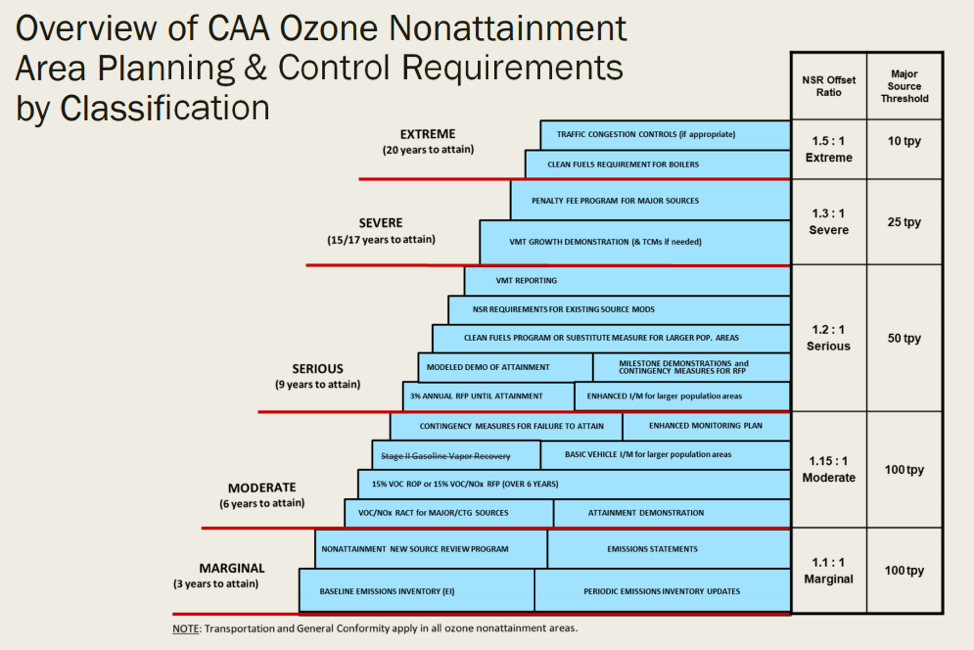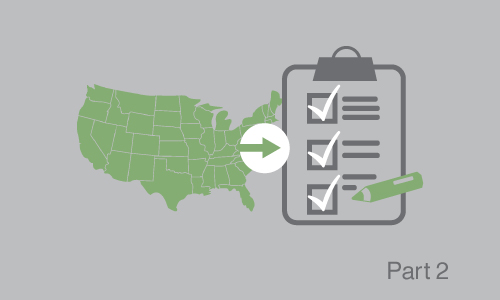Following the announcement in the Federal Register that certain areas are no longer in Moderate nonattainment and will soon be moved to Severe nonattainment specifically for Ozone, many manufacturers in this area may face new expectations, regulations, and standards in the coming year regarding their emissions. In the coming months, states in charge of these areas will submit new State Implementation Plans (SIPs) for reducing ground-level Ozone to comply with 2008 National Ambient Air Quality Standards (NAAQS).
While this may only pertain to certain areas, the 2015 standards are rapidly approaching their enforcement dates, lowering the levels of permissible 8-hour Ozone even lower (from 0.075 ppm to 0.070 ppm, with the emission statement rule and other definitions due August 2020). For more information, we welcome you to read the full Federal Register announcements of the 2015 Ozone NAAQS and reclassification of the seven nonattainment areas.
Execution of State Implementation Plans
In our last blog, we discussed the process by which states submit implementation plans to the EPA. This article covered the Air Quality Management Cycle, attainment/nonattainment designation, and the groundwork states need to lay before a state can submit and the EPA can approve a plan. Today, we would like to turn our attention to the execution, discussing the components of a State Implementation Plan, the execution, enforcement, and what it may mean for your firm.
Related: The Global Cost of Air Pollution and the Health Benefits of Clean Air
Following the approval of a SIP, the plan becomes federally enforceable, allowing the state to monitor under new standards, issue pre-construction and operating permits for new sources, and enforce the regulations.
Different Requirements for Different Levels of Nonattainment
Depending on the severity of nonattainment, states must develop plans to achieve necessary levels of reductions and develop rules to enforce them.
Determining Necessary Level of Reductions
This is a three-step process as part of the SIP. As severe or extreme nonattainment areas have more ground to cover, the levels of reduction will be steeper and timelines will be longer.
- Correlating “base year” emissions and air quality levels, then projecting the level of emissions that will allow area to meet attainment by deadline
- Determining appropriate mix of programs, controls that will achieve necessary emissions reductions (combination of State, local and Federal programs)
- States do modeling; EPA provides support tools – air quality models, technical assistance, training.
Rules, Requirements, and Timelines for Different Levels of Nonattainment (Ozone-Specific)
When rules are released, dates for execution are set. For ozone, the time to reach attainment ranges from 3 to 20 years, as defined under NAAQS. For example, the Extreme area attainment date for locations including San Joaquin Valley and Los Angeles South Coast are 2032 to attain the 2008 standard and 2013 for the 2015 Ozone NAAQS.
The image below shares the basics of planning for attainment, which we will discuss in greater detail below:

(Source)
Knowing this, the reductions required and regulations imposed increase as well, as we discuss below:
Marginal Nonattainment (3 Years to Attain)
The lowest level of nonattainment, those areas considered to have an area design value up to but not including 0.086 ppm (2008), with the limit for Marginal nonattainment dropping to 0.081 ppm under 2015 standard.
Requiring little more than consistent monitoring, those considered to be in marginal nonattainment are held to the following standards. Additionally, Title V major source permits and required emissions statements from these sources are only required for those facilities in excess of 100 tons per year (Note: recent changes to the Once-In, Always-In policy may give facilities previously labeled major sources more flexibility).
- Adopt an emissions statement rule for stationary sources
- Baseline emission inventory (EI), followed by periodic EI updates
- Implement nonattainment area preconstruction program
- New source review (NSR) program (NSR offset ratio 1.1:1)
Under 2015 Ozone NAAQS, the marginal area attainment date is August 2021.
Moderate Nonattainment (6 years to attain)
As the emissions levels increase, requirements do as well. Those with design value of 0.086 up to but not including 0.100 ppm (2008) and 0.081 up to but not including 0.093 ppm (2015) are required to meet moderate nonattainment standards.
Areas labeled moderate need to set goals for attainment, determine reasonably attainable control technology and demonstrate progress, as previously adopted federal measures are not considered to bring areas into attainment.
- All requirements for Marginal classification,
- Major source threshold 100 tpy
- NSR offset ratio 1.15:1
- Major source volatile organic compounds/nitrogen oxides (VOC/NOx) reasonably available control technology (RACT)
- Attainment demonstration
- 15% reasonable further progress (RFP) over 6 years
- Basic emissions inspection and maintenance (I/M) program
- Contingency measures for failure to attain
- Stage II gasoline vapor recovery
Moderate areas were to reach attainment for the 2008 Ozone NAAQS by July 2018 and are expected to meet the coming 2015 NAAQS by August 2024.
Serious Nonattainment (9 years to attain):
While moderate and marginal nonattainment areas have somewhat minor changes needed, those areas labeled under the serious nonattainment category (design value of 0.100 up to but not including 0.113 ppm (2008) and design value of 0.093 up to but not including 0.105 ppm (2015)) face much more stringent requirements. Expected to present reasonable further progress at an 18% annual clip, the major source threshold is halved to 50 tons per year.
As seven areas were reclassified from moderate to serious in recent months, manufacturers will face new challenges in years to come as new SIPs are rolled out.
- All requirements above, with
- Major source threshold 50 tpy
- NSR offset ratio 1.2:1
- 18% RFP over 6 years
- Enhanced monitoring plan
- Modeled demo of attainment
- Milestone contingency measures for RFP
- Enhanced I/M
- Clean fuels program (if applicable)
- NSR requirements for existing source MODS
- Vehicle miles traveled (VMT) demonstration, and transportation control measures if needed
Serious area attainment dates for the 2008 standard are July 2021 and August 2027 for the 2015 NAAQS. The 2008 attainment date for recently reclassified areas will be announced when the reclassification is finalized.
Severe (15 or 17 years to attain)
Areas classified under severe nonattainment are classified as Severe-15 or Severe-17, representing the expected timeline for attainment of 15 and 17 years, respectively. Notably, for these areas, the 1997 NAAQS attainment date is still in the future.
| Severe-15 | Severe-17 | |
| Design Value Range (1997) | Design value of 0.120 up to but not including 0.127 ppm | Design value of 0.127 up to but not including 0.187 ppm |
| Design Value Range (2008) | Design value of 0.113 up to but not including 0.119 ppm | Design value of 0.119 up to but not including 0.175 ppm |
| Design Value Range (2015) | Design value of 0.105 up to but not including 0.111 ppm | Design value of 0.111 up to but not including 0.163 ppm |
| Attainment Date (1997) | June 2019 | June 2021 |
| Attainment Date (2008) | July 2027 | July 2029 |
| Attainment Date (2015) | August 2033 | August 2035 |
As noted, this is the first area where major stationary sources begin receiving penalties, while seeing the major source threshold once again halved to 25 tons per year.
- All requirements above, with
- Major source threshold 25 tpy
- NSR offset ratio 1.3:1
- VMT growth offset
- Low VOC reformulated gas
- Penalty fee program for major sources
Extreme (20 years to attain)
The final category, reserved for only two areas labeled “extreme” requires areas to take measures over the course of 20 years to drastically reduce the VOCs and NOx produced. For all areas exceeding 0.187 ppm (1997), 0.175 (2008), or 0.163 (2015), the major source threshold is cut to 10 tons per year and SIPs require major changes:
- All requirements above, with
- Major source threshold 10 tpy
- NSR offset ratio 1.5:1
- Clean fuels requirement for boilers
- Transportation congestion controls
Attainment dates are as follows: June 2024 (1997), July 2032 (2008), August 2038 (2015).
Building, Expanding, or Modifying? Plan Ahead
State Implementation Plans, as explained in a presentation on the topic, are “enough paperwork to fill an 8×8 room from floor to ceiling.” Paired with the Clean Air Act’s 20,000+ page set of regulations, and it may feel like an impossible to climb mountain. At The CMM Group, we know what it takes to help you become and remain compliant under CAA rules and your unique state requirements, and we design the products you need to get there.
Whether you are working to remain compliant when expanding, find a solution that reduces operating costs while destroying pollutants, or prepare for new requirements set by your state in coming years, we’re here to help. Learn more about our work, download our guide to VOC abatement, and contact us for more information.
Additional Information
- Regional Pollution Control Resources, Grants, and Opportunities
- Links for All State Requirements and Resources
- Development of Specific Elements for Each of the Major SIP Types
- Nonattainment and Ozone Transport Region (OTR) SIP Requirements
- The Science of Pollution Control: Destruction Efficiency
- PART 51—Requirements for Preparation, Adoption, And Submittal Of Implementation Plans
- The Basics of State Implementation Plans
- How VOCs contribute to Ozone
- Ozone NAAQS Timelines
- Current Nonattainment Counties for All Criteria Pollutants




